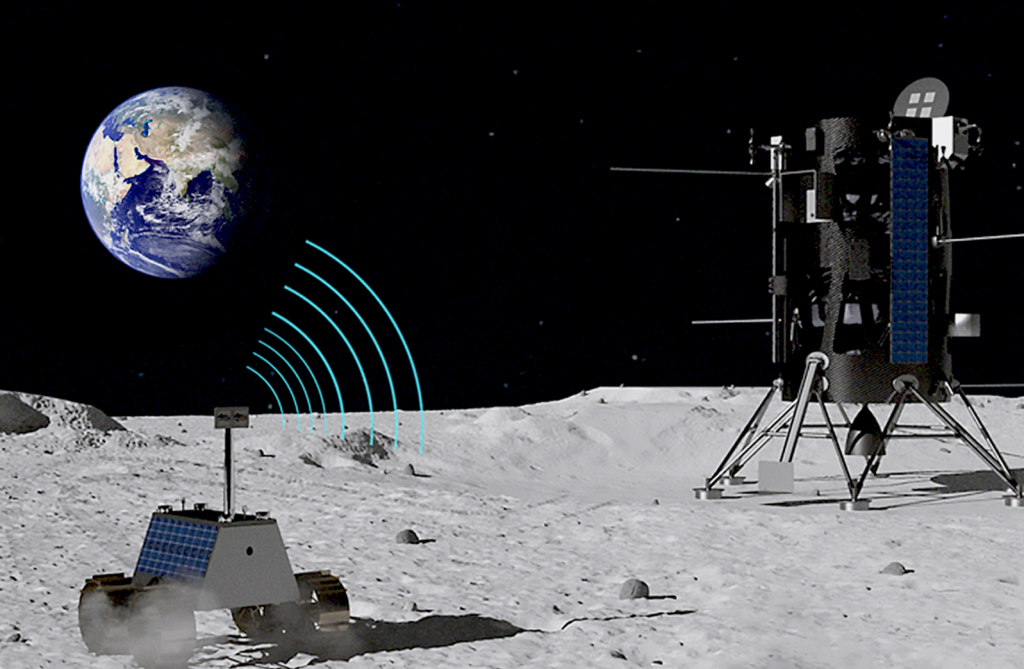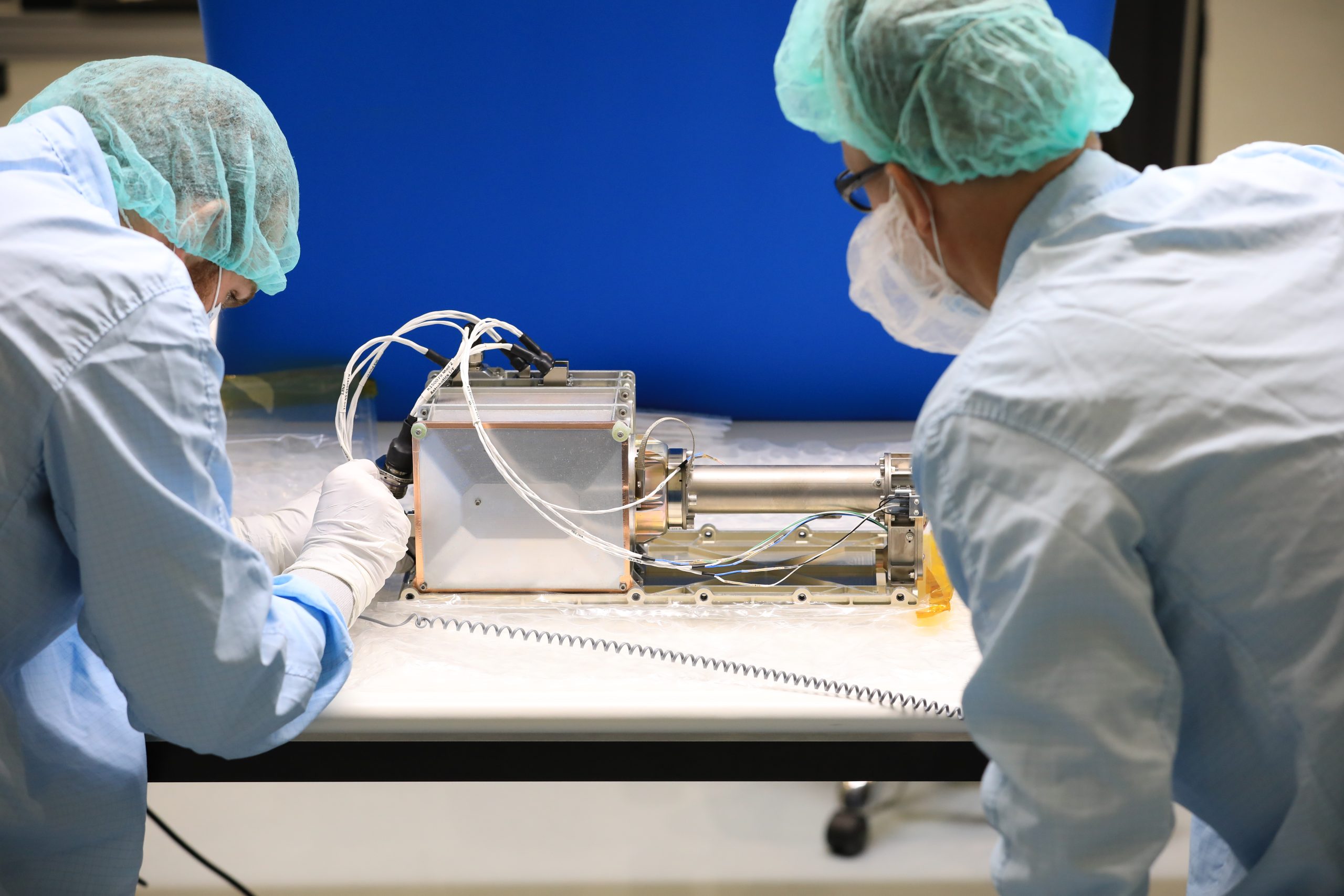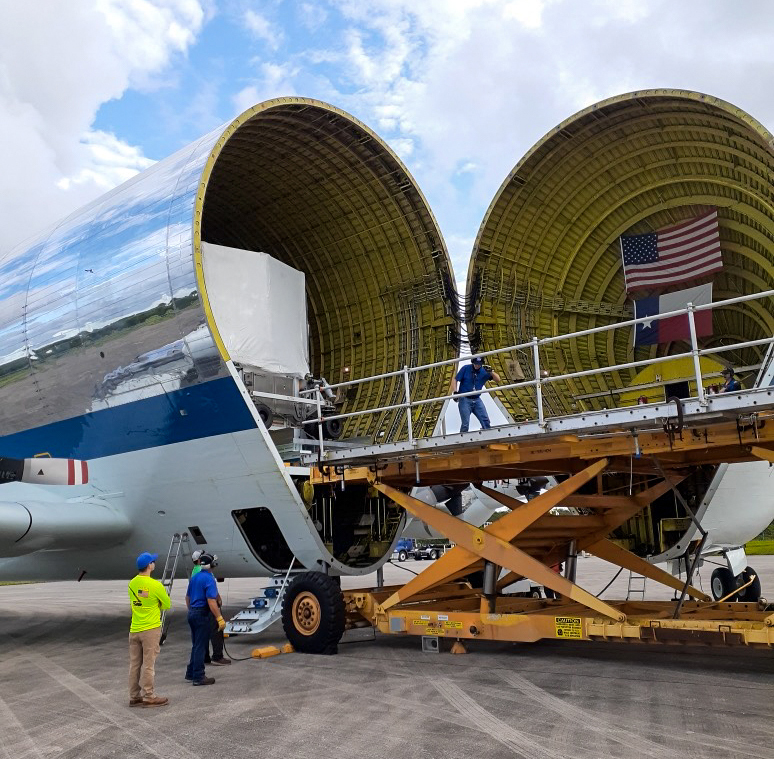NASA is progressing through the Green Run test series for the Space Launch System (SLS) rocket at the agency’s Stennis Space Center in Mississippi and has completed six of the eight tests. The team is preparing to stand down for another tropical weather system that is heading to the area. The pause in work comes ahead of the most complex tests: wet dress rehearsal, when propellant will be loaded for the first time, and hot fire, when all four engines will be fired and every system within the stage will operate. During the pause, engineers will continue to assess data from recent tests to ensure the team is ready to proceed to the next phase of testing. Green Run testing is a complex series of tests to methodically and thoroughly check all the rocket’s core stage systems together for the first time to ensure the stage is ready for flight. Check back at this blog for an update on adjusted dates for the Green Run wet dress rehearsal and hot fire tests, after the storm has passed.
Hello, Moon? It’s NASA Calling
As part of the Artemis program, NASA aims to establish sustainable exploration on the Moon by the end of the decade. To support that vision, our team in space tech continues to initiate public-private partnerships to develop the infrastructure, such as communications and power, needed for a long-term lunar presence.
NASA’s current lunar concept calls for an Artemis Base Camp on the South Pole, built with commercial and international partners. A lunar terrain vehicle (LTV), a mobile home and a lunar cabin on the surface would provide astronauts the ability to explore more of the lunar surface and stay on the Moon for longer periods of time than ever before.
Just like here on Earth, space cars and homes will require power and communications capabilities. Unlike what’s often depicted in sci-fi films though, there are many challenges to communicating in space, such as delays and bandwidth, among others. Technology advancements could make lunar calling plans much easier in the near future.
Whether our astronauts are traveling to the surface aboard a modern human landing system, exploring during a moonwalk, roving around in the LTV, working in a mobile home on the Moon, or even aboard the Gateway in lunar orbit, communication is critical between Earth and among crew in all these activities planned for the Artemis program.
Inspired by Earth-based communications technologies, Nokia Bell Labs recently proposed to NASA the first cellular communications network on the Moon. Their idea is to deploy an end-to-end communication system on the lunar surface using LTE technology. The initial proposed Nokia network would be used for proximity communications on the lunar surface, providing wireless network coverage around the landing module. In the future, this technology and its evolution also could be used for providing communications to and from a spacecraft orbiting the Moon.
During our evaluation of this proposal, we found it’s a promising technology that could meet needs for the agency as well as other potential lunar customers. Nokia would use a commercial Moon delivery service provider, an initiative created by NASA, to deliver hardware to the lunar surface in late 2022.
That proposal was one of 15 “tipping point” technologies we recently selected and NASA’s Space Technology Mission Directorate will invest in to advance commercial systems supporting human exploration of the Moon and Mars.
Through our Lunar Surface Innovation Initiative we are targeting communications as one of its top areas to advance technology readiness levels for deep space. Another surface innovation we want to advance is power generation. With a constant energy source from the Sun for solar power or the potential to extract and convert resources on the Moon to expand exploration capabilities, NASA is considering many options to power a broad range of systems in orbit and on the surface of the Moon. In response to the same tipping point solicitation, we selected several proposals related to power generation and energy storage.
Precision Combustion aims to mature a deep space fuel product that could be used for power generation and energy storage. Using a modern solid oxide fuel cell stack developed by the company, lunar customers like NASA would be able to generate power directly from propellants (methane/liquid oxygen) and in-situ resources. The proposal received high marks from NASA because of the technology readiness level, maturation plan, and fact that it can be used anywhere on the Moon.
Long-term, the use of space-based resources is key to reducing the cost of deep space travel and reducing dependence on supply shipments from Earth. Precision Combustion believes its approach could result in as much as 10 times the reduction in the cost of equivalent power generation.
Both of these technologies will receive milestone-based investments from the agency, with Nokia receiving an award of about $14 million, and Precision Combustion receiving $2.4 million.
We reviewed dozens of proposals and found these two responses plus 13 others to have some of the highest potential to provide substantial benefit to government and other customers if they reach the market.
The expected combined award value for our most recent tipping point investments is more than $370 million. We look forward to partnering with Nokia and Precision Combustion as well as Eta Space, Lockheed Martin, SpaceX, United Launch Alliance, Alpha Space, Astrobotic Technology, Intuitive Machines, Masten Space Systems (on two proposals), pH matter, Sierra Nevada Corporation, Maxar Technologies, and Teledyne Energy Systems. The firm-fixed price contracts with each company could last up to five years, and the goal is to help the technology reach a successful in-space demonstration without further government investments before ultimately becoming commercially available.
This decade, the Artemis program will lay the foundation for a sustained long-term presence on the lunar surface. As humanity’s lunar presence and capabilities grow, we look forward to using our knowledge gained from activities on the Moon to prepare for our next giant leap – human exploration of Mars – as early as the 2030s.
– Jim Reuter, associate administrator for NASA’s Space Technology Mission Directorate

Mobile Launcher Arrives at Launch Pad 39B for Tests, Preps for Artemis I

The Exploration Ground Systems and Jacobs teams rolled the mobile launcher, atop crawler-transporter 2, out of the Vehicle Assembly Building for its slow trek to Launch Pad 39B at Kennedy Space Center in Florida on Oct. 20.
The roll began just after midnight, and the mobile launcher arrived at the top of the pad Tuesday morning. This trek to the pad will help prepare the launch team for the actual wet dress rehearsal and launch of SLS and Orion on Artemis I next year. The wet dress rehearsal is when SLS and Orion will be rolled out to the pad atop the mobile launcher to practice fueling operations a couple months before launch. The last time the mobile launcher was rolled to the pad was in December 2019.
During its two-week stay at the pad, engineers will perform several tasks, including a timing test to validate the launch team’s countdown timeline, and a thorough, top-to-bottom wash down of the mobile launcher to remove any debris remaining from construction and installation of the umbilical arms.
>>Read more
Orion Solar Array Wing Installation Complete for Artemis I
Teams from NASA, Lockheed Martin, the European Space Agency (ESA), Airbus Defence, and Airbus Netherlands have completed the meticulous installation of Orion’s four solar array wings. The arrays will supply energy to the service module that will power and propel the spacecraft during NASA’s Artemis I mission. They were fitted onto the European Service Module (ESM) inside the Neil Armstrong Operations and Checkout Building at the agency’s Kennedy Space Center in Florida.
Activities on the spacecraft continue to move forward — the next set of final installations include the spacecraft adapter jettison fairings, which enclose the service module, and forward bay cover, protecting the upper part of Orion including its parachutes throughout its mission. Once complete, the spacecraft will begin its journey through Kennedy to be integrated with its launch abort system and ultimately, the Space Launch System (SLS) rocket for launch from Kennedy’s Launch Pad 39B.
>>Read more
Artemis I Networks for Communication and Navigation
Artemis I will demonstrate NASA’s networks’ comprehensive services for journeys to lunar orbit. The mission requires all three of NASA’s major networks to work in tandem, providing different communications and tracking service levels as Orion leaves Earth, orbits the Moon, and returns safely home.
Communications services allow flight controllers in mission control centers to send commands to the spacecraft and receive data from Orion and SLS systems. Tracking, or navigation, services enable the flight controllers to see where the spacecraft are along their trajectory through space.
>> Read more
SLS Core Stage Passes Simulated Countdown Test

Engineers at NASA’s Stennis Space Center near Bay St. Louis, Mississippi, completed a simulated launch countdown sequence on Oct. 5 for the sixth test of the eight-part core stage Green Run test series for NASA’s Space Launch System (SLS) rocket.
The rocket’s core stage has three flight computers and avionics systems to help launch and guide NASA’s Artemis missions to the Moon. During the simulated countdown, NASA engineers and technicians, along with prime contractors Boeing, and Aerojet Rocketdyne, monitored the stage to validate the timeline and sequence of events leading up to the test, which is similar to the countdown for the Artemis I launch.
The countdown sequence for an actual Artemis launch begins roughly two days prior to liftoff. In addition to all the procedures leading up to the ignition of the four RS-25 engines, the SLS core stage requires about six hours to fully load fuel into the two liquid propellant tanks. The simulated countdown sequence test at Stennis began at the 48-hour mark as if the stage was first powered up before liftoff. Engineers then skipped ahead in the sequence to monitor the stage and procedures of the stage 10 minutes before the hot fire. The simulated countdown sequence is one of the final tests of the SLS Green Run campaign. The series of tests is designed to gradually bring the rocket stage and all its systems to life for the first time.
Artemis Instrument Ready for Extreme Moon Temperatures

A versatile instrument designed to help analyze the chemical makeup of lunar landing sites and study water on the Moon as part of the Artemis program has completed an important step in its final assembly.
Teams working on the Mass Spectrometer Observing Lunar Operations, or MSolo, at NASA’s Kennedy Space Center in Florida installed the radiator – a critical component that will keep the instrument’s temperature stable in the extreme heat and cold it will encounter on the Moon.
MSolo is a commercial off-the-shelf mass spectrometer modified to work in space. NASA will use MSolo to identify molecules on the surface of the Moon. Multiple MSolo instruments are destined for the Moon via the help of NASA’s commercial partners, landing scientific instruments and technology demonstrations on the lunar surface as part of the Commercial Lunar Payload Services (CLPS) initiative.
NASA has scheduled MSolo instruments to launch on future robotic missions starting in 2021 at Lacus Mortis, a large crater on the near side of the Moon. MSolo is a key component of the Polar Resources Ice Mining Experiment, or PRIME-1, instrument suite that will use a drill to harvest ice just below the lunar surface in 2022. Later, the technology will be one of three instruments on board NASA’s water-hunting Volatiles Investigating Polar Exploration Rover, VIPER, scheduled to launch to the Moon’s South Pole in late 2023.
On VIPER, the MSolo instrument will help evaluate subsurface soil cuttings brought up by a 3-foot drill in search of water ice and other volatiles that future missions could use as resources. The mission will create the most detailed view of the Moon’s water to date – helping to pave the way for the lunar surface missions with crew beginning in 2024.
Artemis I Rocket and Spacecraft Receive “Worm” Welcome

NASA is headed back to the Moon as part of the Artemis program – and the agency’s “worm” logo will be along for the ride on the first integrated mission of the powerful Space Launch System (SLS) rocket and Orion spacecraft. Teams at NASA’s Kennedy Space Center in Florida have applied the historic logo in bright red on visible parts of the Artemis I rocket and spacecraft.
>> Read more
Orion Test Articles Arrive to Kennedy for Testing on Future Artemis Missions

The Orion Service Module Structural Test Article (SM-STA), composed of the European Service Module (ESM) and Crew Module Adapter (CMA), arrived at NASA’s Kennedy Space Center in Florida following the completion of the test campaign to certify the Orion Service Module for Artemis I. Transported via Super Guppy from Lockheed Martin’s test facility in Denver, Colorado, on Sept. 11, components will now be used in testing for future Artemis missions.
“The Orion SM-STA supported testing in multiple configurations to validate the structural robustness of the vehicle under a variety of conditions that a spacecraft will experience on lunar missions for the Artemis program,” said Rafael Garcia, Orion Test and Verification lead.
At Kennedy, the Orion SM-STA test article will be separated from the CMA test article, and portions of the CMA test article will support qualifications tests in preparation for the Artemis II mission. The test version of the ESM will remain at Kennedy, in order to support future structural qualification tests such as testing what volume of sound and how much shaking the vehicle can handle for future Artemis missions.
When tested together, the full test stack of Orion verified the spacecraft’s structural durability for all flight phases of the Artemis I flight, which is designed to be an opportunity to test the kind of maneuvers and environments the spacecraft will see on future exploration missions. The test structures experienced launch and entry loads tests, intense acoustic vibration force, and shock tests that recreate the powerful blasts needed for critical separation events during flight. A lightning test was performed to evaluate potential flight hardware damage if the vehicle were to be hit by lightning prior to launch.
The Artemis II flight will test a hybrid free return trajectory, which uses the Moon’s gravitational pull as a slingshot to put Orion on the return path home instead of using propulsion. With astronauts aboard the spacecraft, additional validation is required of all vehicle components to certify the capsule prior to proving lunar sustainability with Artemis III and beyond.
The first in a series of increasingly complex missions, Artemis I will test the Orion spacecraft and Space Launch System as an integrated system ahead of crewed flights to the Moon. Under the Artemis program, NASA will land the first woman and the next man on the Moon in 2024.
Artemis Plan to Land First Woman, Next Man on Moon in 2024
Following a series of critical contract awards and hardware milestones, an update on NASA’s Artemis program is now available, including the latest Phase 1 plans to land the first woman and the next man on the surface of the Moon in 2024.
In the 18 months since NASA accepted a bold challenge to accelerate its exploration plans by more than four years and establish sustainable exploration by the end of the decade, the agency has continued to gain momentum toward sending humans to the Moon again for the first time since the last Apollo mission in 1972.
The document captures Artemis progress to date, identifying the key science, technology and human missions as well as the commercial and international partnerships that will ensure we continue to lead in exploration and achieve our ambitious goal to land astronauts on the Moon.
>>Download and read the Artemis Plan

